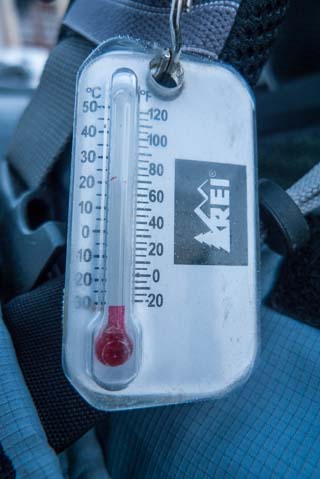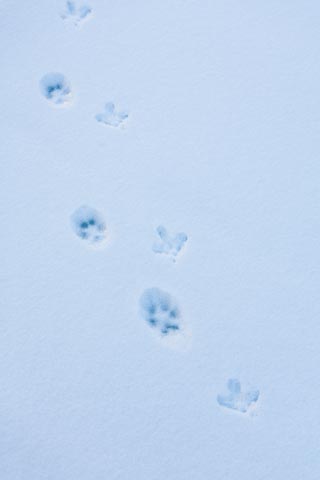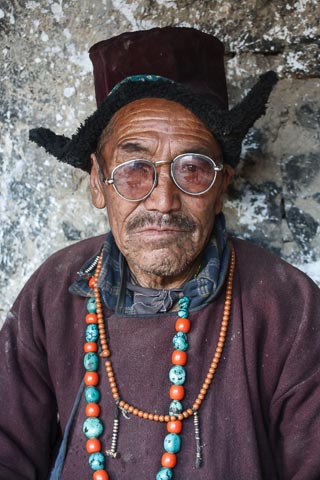Detailed itinerary
Our itinerary is a rough idea of where we plan to go only, and the timing correct assuming reasonable conditions, although with some extra days to cope with some unexpected events. However we are entirely dependent on weather conditions and will adapt as needed.
The trip is finely timed with normal winter conditions however there is a strong El Nino-ENSO signal and I haven't been able to assess whether this might help (colder, more snow) or hinder us (warmer). It is worth pointing out that the summer of 2015 was one of the warmest on record, however Ladakh temperatures were one of the few places on the planet cooler than average.
We are trekking from low altitude to higher, and so start in proper winter, and while Leh may be warmer at the end of the trip, snow starting to melt, the Changtang should still be at the end of real winter. This direction is also our friend with the altitude.
Leh start
We begin all our Ladakh treks in Leh so it is your responsibility to get your
ticket to Leh, see our Delhi-Leh travel
advice.
Day 0 - Arrive Delhi
You should arrive in Delhi today OR very early morning tomorrow morning (before
3am), with at least 4 hours between arrival in Delhi and departure to Leh, to
allow for some delays; flight-disrupting winter fog in Delhi is common. Bring a
magazine or book and some patience.
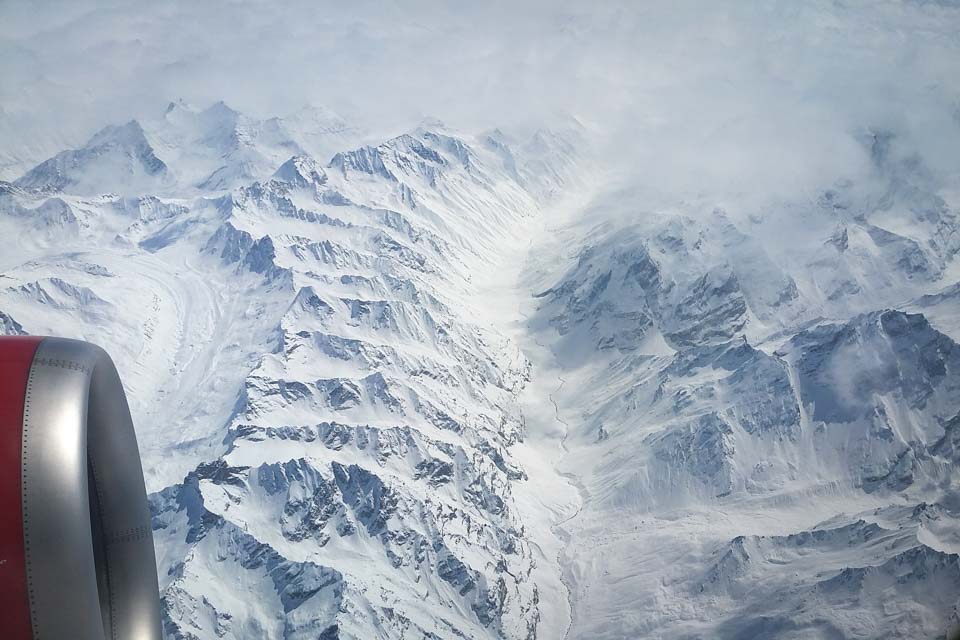
A snowy world - Jamie
Day 1 - Arrive Leh 3500m
The cold air will take your breath away, and you will feel the altitude. We meet you at the airport and
head to a
centrally heated hotel, which in Leh means it will not be freezing - but will not be toasty warm either.
After a late
breakfast, we take a slow stroll around Leh, with its old palace dominating the old bazaar and run a gear check, sorting the last details. This is also a quiet day to recover from the long flights to get here.
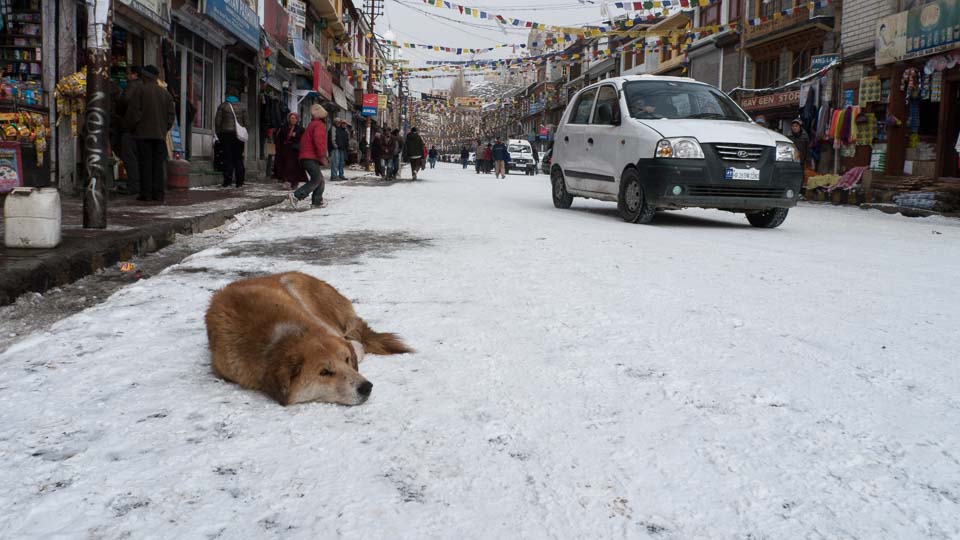
The main bazaar, the main street, in Leh - Jamie
Day 2 - Leh 3500m
Today we explore the alleyways of historic Leh, and the striking Indus valley with its snowy
backdrop that surrounds it, visiting some of the ancient forts and gompas of the Tibetan Buddhist world. It is a
piece of central Asian history, the fort and palace, colorful gompas, the
mosque and back alleys with steaming Muslim bread, and of course, the
11 am ice hockey match!
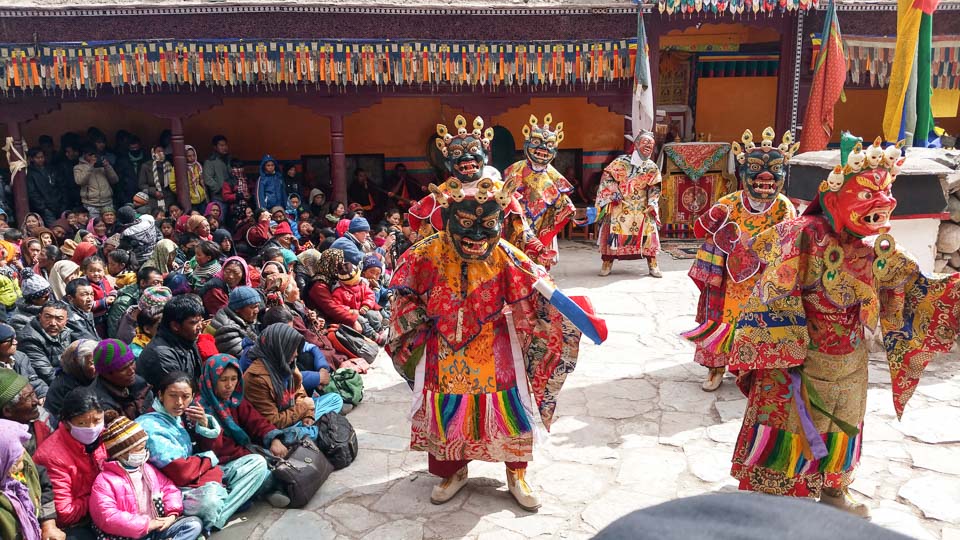
A winter cham, lama dance, at Matho Gompa - Jamie
Day 3 - drive Chilling, trek Tilat Sumdo 3190m or further
Decades ago, the Zanskaris would drag sleds loaded with butter from Padum to the Indus River junction at Nyemo before transferring on to animals but now we drive not only to the junction, where the Zanskar and the Indus merge colours, but along the Zanskar to beyond Chilling, virtually to the point of the photo below, where the Karnak River enters. The drive is stunning, looking over ice blue glittering river and indeed it is somewhat of a shame the road is driveable in winter as starting trekking from the junction would be more intimidating, slow the transition to mass trekking tourism in an area that can't handle it.
After a quick scout of our side route and if conditions are good, and not overrun by large groups, we will wander along the Chadar, the Zanskar River, and find a cave to sleep in, in the spirit of the real Chadar.
Trekking on the ice really is an edgy, surprisingly exhilarating experience, and although the world around us is frozen, little is static, as the river flows underneath us and beside us, and sometimes over the ice we are standing on too.
If conditions are perfect in the Karnak valley though, and the Chadar crowded, we may yet skip this jaunt up the Zanskar. Let's see.
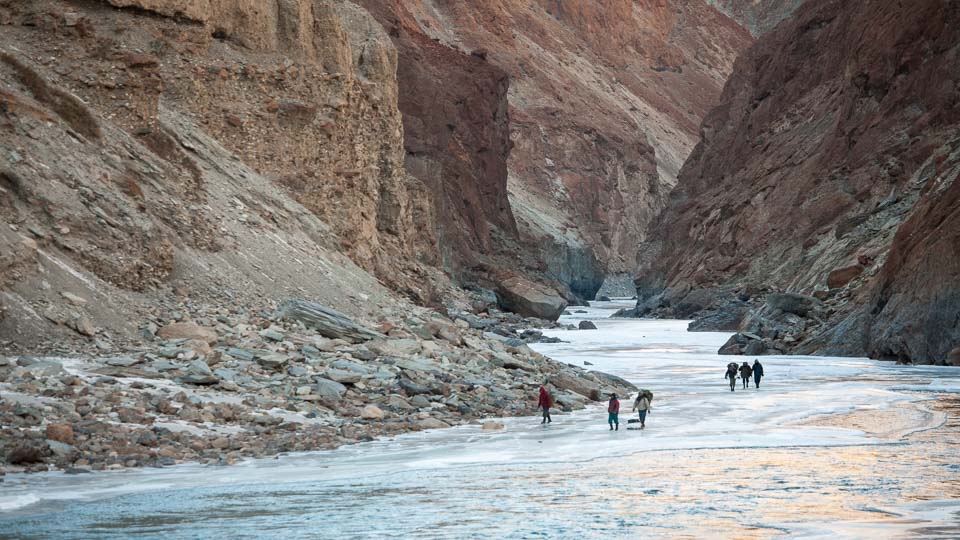
The start of the Chadar at Tilat Sumdo - Jamie
Day 4 - Chadar exploration
We are not walking the entire Chadar but this section we are on is as exciting and photogenic as anywhere. We will probably retrace our steps today and head up the Karnak Chu a little way. During summer the Karnak Chu is quite a large river, although the flow is still less than the Zanskar River with its drainage further south in areas with higher precipitation. Surprisingly though the ice walking is more challenging, the ice far less solid, less predictable.
Days 5-8 - trek Karnak Chu 3200m to Tsogra 4230m
Our unique adventure begins. For the first five kilometers or so we may face particularly tough ice conditions, I did in 2010 but the locals assured me it gets more straightforward after that. Perhaps surprisingly the lower volume river flow makes it harder to traverse than the solid Zanskar ice, however conditions should improve the further in we go as the valley widens out slightly.
This is also a predator corridor, a link between the high wild areas of the Karnak, and the lower rocky gorges favoured by blue sheep, and snow leopard foot prints are everywhere; spotting the elusive ghost of the ice is far harder though.
This four day gorge walk will be hugely challenging and is the crux of our trip. We have to camp carefully, away from avalanche danger, and sometimes the safest or even only spots are caves used by the locals. There are options for an alternative exit over high and rough passes to the Markha Valley, or we can simply turn back if necessary, and dirvert to another area. We will give it our best and let's see how we go!
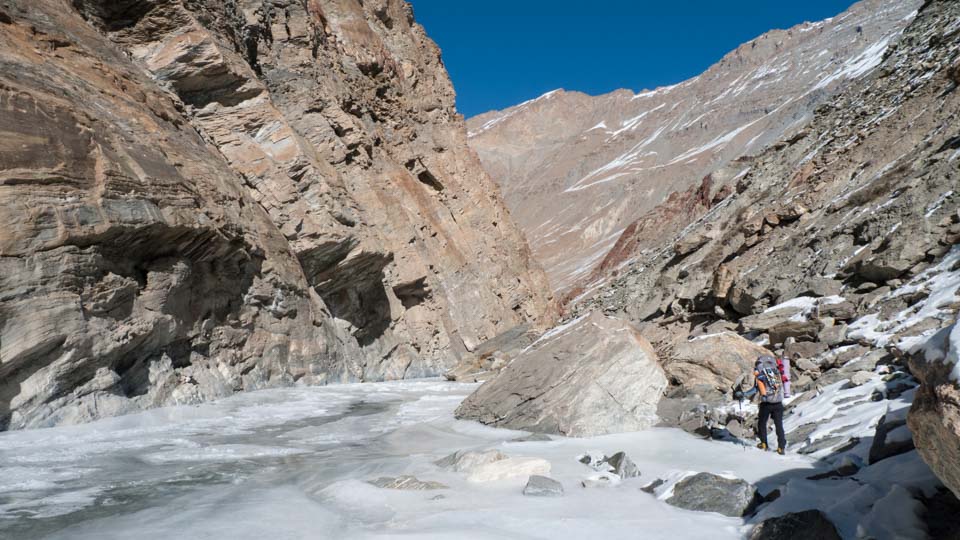
A tricky section up the Karnak Chu, fun with sleds - jamie
Day 9 - rest-explore Tsogra 4230m
A little before Tsogra (also called Sorra) is a junction and we briefly leave the main valley to meet the winter dwellers that are descreetly tucked up a side valley. Apparently this is the area where they take yaks for the winter, and is definitely remote.
In 2015 we explored a route from Tsogra to Gya, over a 5950m (!) pass but that won't be a winter option.
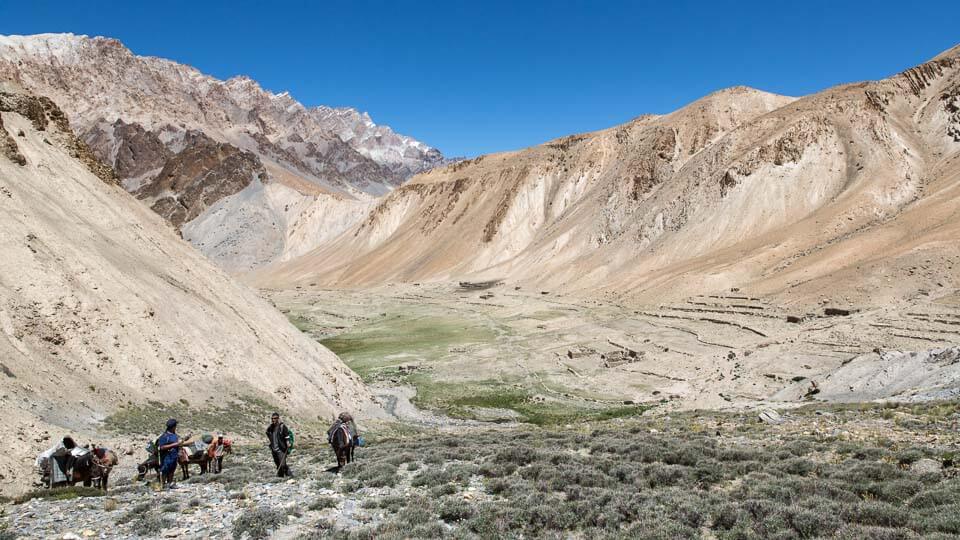
Tsogra is deserted in summer - Jamie
Day 10 - trek Dad 4310m
On familiar territory, it is normally sandals trekking and less than a day from Tsogra to Dad along a delightful stream in an awesome gorge; with winter conditions it is likely to look rather different, however it is a route used by the local herders- and wolves and snow leopard.

Delightful summer trekking, and will be rather whiter but hopefully good winter trekking too - Jamie
Days 11-16 - trek Pungunanu 4600m
Leaving the winter settlement of Dad we head up the broadening valley ringed by peaks with seemingly no way out. However tucked around a corner is the Yar La at 4960m, a substantial barrier for our success. We now approach our second test for our sledding style, when the ice runs out, is there enough snow? I really hope so as there is a gently graded road over so while the height of the pass may be intimidating with our loads, the terrain should not be. If there is no snow we should be able to get horses in Dad.
At the top of the pass the vista opens out to kiang (Tibetan ass) country and after an initial zigzag descent, I hope the broad valley is easy travelling on the frozen stream or narrow road. There are several nomad winter settlements who will be rather surprised to see us as they are quite isolated, cut off from anywhere else if there is real snow on the ground. However it is these settlements that my ideas may suit the most, we investigate, perhaps obliquely initially, as it will take a united community to successfully move forward with a real project.
There are several possible routes now but the most likely is to gently ascend to the More Plains along side the empty Manali-Leh road, which is almost certainly blocked at the Tanglang La. We only have a little distance on the highway before branching off to the water spring and winter settlement closer to Tso Kar.
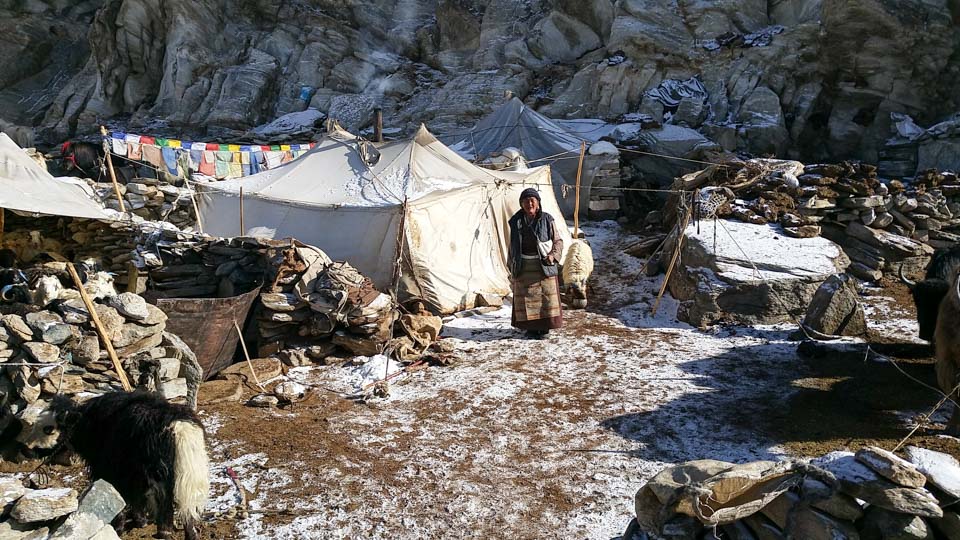
Tents are surprisingly practical for the winter temperatures, heating quickly - Jamie
Days 17-20 - trek Thugje 4560m or Puga 4420m
The salt lake of Tso Kar is the real Changtang (also spelt Changthang) and usually gets little snow in winter, hence we come later when there is more likely to be some around. However trekking with horses settlement to settlement is also an option, and indeed there is a skinny road here too, and we can be picked up where ever the reliable and experienced Ang Chuk can reach. If snowy then we may have to trek to Puga via the gentle 4975m Polongka La.
These areas are also suitable for the project.
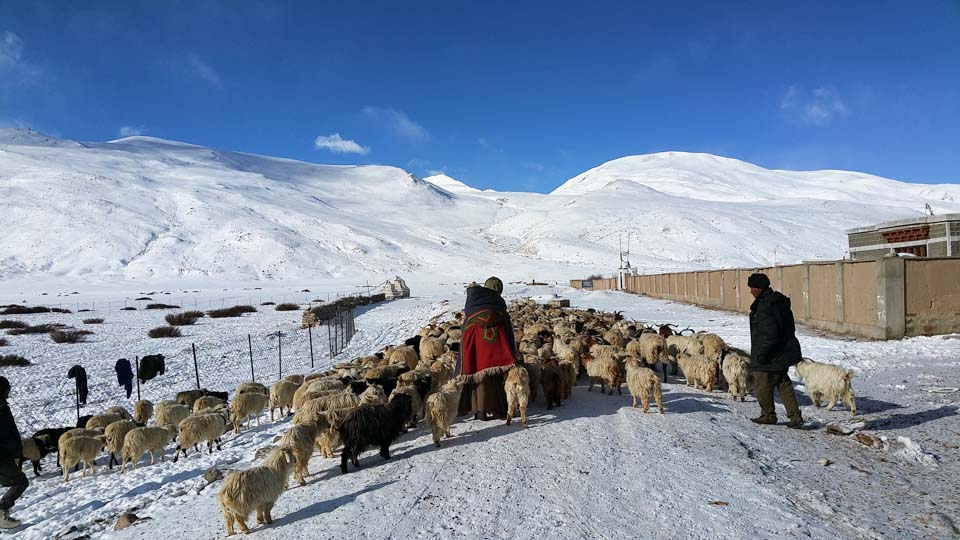
Exercising the sheep and goats at Puga - Jamie
21 - drive Leh
Although road conditions may be marginal around here, the main road along the Indus, which we meet at Mahe Bridge, is virtually always open, an essential supply line for the army.
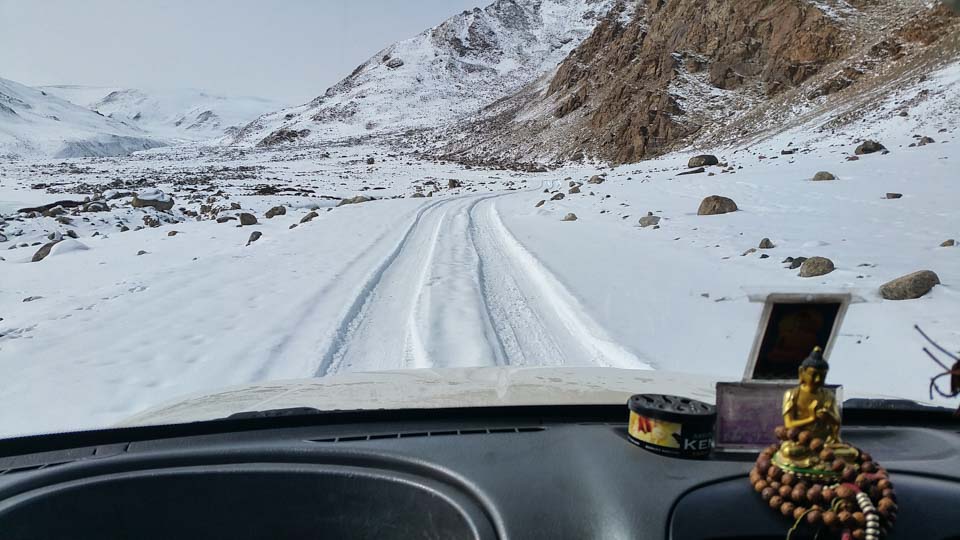
Ang Chuk is a master winter driver - here approaching Puga - Jamie
22 - Leh
An extra day for some of the inponderables.
Day 23 - depart
We take you to the airport for a morning flight. Do see our notes and suggestions at the end of the Tentative itinerary.
Julley!




